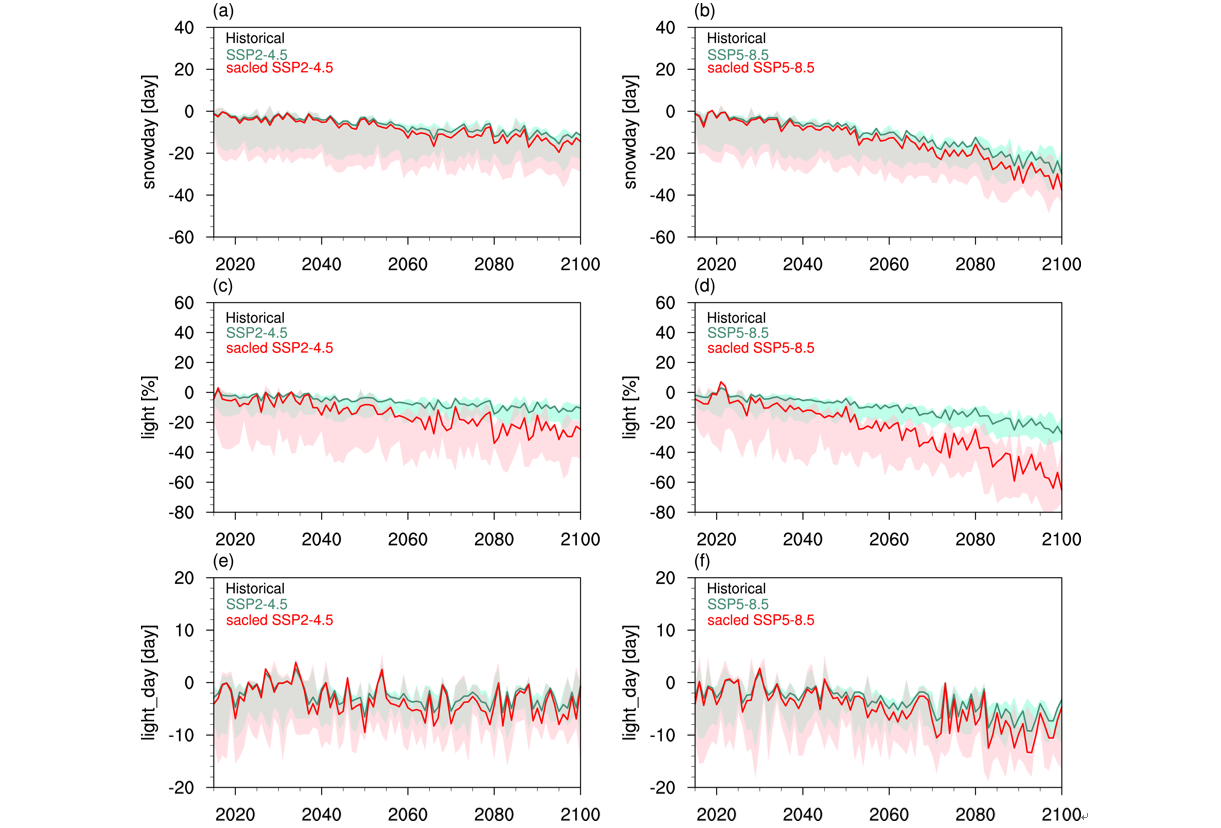【中文介绍】
近年来,欧亚大陆部分地区极端降雪事件频繁发生,不仅造成了巨大经济损失,也给交通、能源、农业和人民生活生产等带来了严重影响。但受制于降雪观测资料匮乏、模式模拟性能等客观因素,目前人类活动对降雪变化的影响尚不清楚。基于CMIP6模式多种强迫试验结果,利用“正则化最优指纹法”等方法,对欧亚大陆不同等级降雪(总降雪、小雪(<2.5 mm/day)、强降雪(>5mm/day))及其日数变化进行检测与归因研究,探究了人类活动对欧亚大陆地区降雪变化的可能影响;基于归因结果,进一步分析了在SSP2-4.5和SSP5-8.5变暖情景下欧亚大陆降雪的未来变化趋势,该结果于近期在线发表在国际期刊《Atmospheric Research》上。
研究结果指出,全强迫、人类活动强迫和温室气体强迫试验均能合理再现欧亚大陆降雪的时空变化特征;且在90%的置信区间内,可以检测到人类活动强迫对欧亚大陆降雪日数、小雪雪量和小雪日数的影响。与此同时,在降雪日数和小雪雪量的变化中,温室气体强迫作用也能在90%的置信区间被检测到。因此,人类活动对欧亚大陆降雪日数、小雪雪量和小雪日数的减少起到了一定的作用,其中温室气体强迫对降雪日数和小雪雪量的减少起主导作用,但温室气体强迫均低估了此二者的变化。基于观测约束的预估结果显示,到本世纪末(2081-2100年),在SSP2-4.5(SSP5-8.5)情景下,降雪日数、小雪日数和小雪雪量将分别减少约13.9天(28.3天)、4.3天(8.8天)和24.8%(48.7%)。然而,相比于观测,全强迫、人类活动强迫和温室气体强迫试验对强降雪雪量及日数明显高估;且在各类强迫试验中均无法检测到其对强降雪变化的影响,这可能与模式对较高等级的降雪模拟能力较低有关,需要进一步的改进提升。
【英文介绍】
It has been widely reported that anthropogenic influences are detectable with high confidence in global warming. However, whether human activities have an impact on snowfall changes is still unclear. Here we based on phase 6 of the Coupled Model Intercomparison Project (CMIP6) multi-forcing dataset and the regularized optimal fingerprint method, the detection and attribution of various grades of snowfall (including annual snowfall (>0.1 mm/day), light snowfall (<2.5 mm/day), intense snowfall (>5 mm/day), and their corresponding days) changes in Eurasia (20°-90°N, 10°W-180°E) were carried out. Results show that anthropogenic activity forcing (ANT) and greenhouse gas forcing (GHG) well reproduced the spatial-temporal characteristics of snowfall indices. The ANT influence is robustly detected in the decreased trend of snowfall days (snowday), light snowfall, and light snowfall days (light_day) at the 90% confidence interval, clearly separated from the natural forcing. Moreover, the GHG signals are detectable for decreases in the three snowfall indices, which only could be distinguished from the natural and aerosol forcings for snowday and light snowfall. Thus, anthropogenic activities may considerably account for the decreases in snowday, light snowfall, and light_day across Eurasia, wherein the changes in the first two indices dominated by GHG emissions. However, human influence detections fail for intense snowfall, and it is hard to detect on regional scales, except for North Asia. Finally, by the end of this century (2081–2100), the observation-constrained projections based on the detection and attribution analysis under two SSPs (new Shared Socioeconomic Pathway) scenarios exhibit that the scaled snowday, light snowfall, and light_day are expected to decrease by approximately 13.9 days (28.3 days), 24.8% (48.7%), and 4.3 days (8.8 days) under the SSP2–4.5 (SSP5–8.5) scenario with reference to the current climate (1995–2014). Our study highlights the need to improve climate model performance in simulating extreme snowfall to clear whether and to what extent human influence impacts it.
【关键图表】

【全文链接】
https://www.sciencedirect.com/science/article/pii/S0169809523005227?dgcid=coauthor









